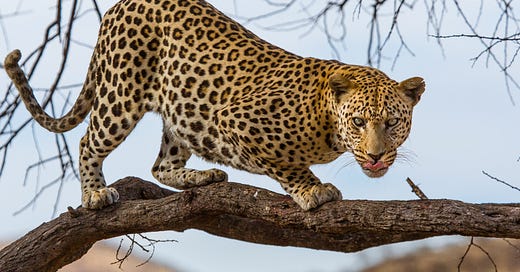by Richard Conniff
Txoma told a story about a neighbor named Tollie, who depended on a pack of hunting dogs because he was deaf. One day, while Tollie busied himself at a pond, his dogs ran around to the other side, where they cornered a leopard in the bush and launched a horrific brawl. Tollie, hearing nothing, wandered over into the middle of it. The leopard promptly leaped up and bit him on the face and sank its claws into his shoulder. But as he started to fall, Tollie drove his spear into the leopard's chest and killed it. Then he stood up, "bleeding like a pig," and walked six miles to a village for help. Stander's team of trackers happened at that moment to be radio-tracking the leopard, which was one of their main study animals.
"So here we are tracking," said Stander, "and we find this leopard lying with a spear through his chest. The San looked around and said, 'These are Tollie's tracks,' and they reconstructed the whole thing. By the time the village people got to us, we knew exactly what had happened."
Stander had been hoping to walk me through such a reconstruction at the site of a recent kill, and that afternoon we hiked up onto a ridge where a leopard had been hanging out. Stander had gotten a glimpse of the radio-collared animal that morning from his airplane.
The ridge was dismal for tracking, all granite pavement and pebbles. But Tkui quickly found footprints. "When the plane went over, the leopard went this way," he said. "She was running." He showed me the depth of the rear prints, and the way the claws had scooped them out in back. Then he pointed to a print where the foot had clearly pivoted in place. "It's stopping here and looking at the plane," he said.
They lost the trail for a while, then separated and wandered ahead to where they thought they might pick it up again. "Tracking is so fundamental in hunting that it must have been extremely important in shaping how our minds work," Stander was saying. "Those who tracked best got more food. There must have been tremendous selection pressure. Watching these guys work, that makes so much sense. What they're doing here is a lot like science. You form a hypothesis about where the animal might have gone, and then you modify the hypothesis."
The two trackers meandered down the length of the ridge, weaving back and forth, sorting out several days' worth of leopard and hyena tracks, the circumstantial evidence of a recent kill. Finally, after about a mile, Tkui stopped, lifted his arm and pointed. A baby giraffe, perhaps 1 month old, lay with its legs splayed, its head twisted to one side, flies circling its open belly, and a paling of broken ribs sticking up on one side.
The two trackers studied the terrain. They traded thoughts on the significance of assorted inscrutable indentations. After they'd reached a consensus, Tkui walked us through the killing. It was three nights ago. The giraffe was lying on top of the ridge sleeping. Right here. The leopard was coming up the slope. Over here. Then it caught the scent. Tkui pointed out the pause in the footprints, and the signs of stalking. "The stopping may have been a half-hour, and the stalking may have been a long time too," Stander translated. "We have no way of knowing." Tkui reenacted the scene, crouching and slowly drawing his feet up between his hands until, after a distance of 80 feet, he came to a spot where there were two deep divots in the soil. It was just 16 feet from the sleeping giraffe. Tkui pawed the earth, digging in like a sprinter on the starting blocks. Then he pounced.
"The leopard landed on its back feet," he said, "and the front feet hit the animal here." He showed us the claw marks on the giraffe's left flank. The leopard lunged for its victim's throat. "As it grabbed on, the giraffe turned away." He then showed us the sweeping, circling marks in the sand. "There was this big struggle. The leopard's back feet dragging, dragging, pulling this thing down." The victim might have weighed 220 pounds, the leopard no more than 90. But the contest was brief. With the leopard locked on its throat, the giraffe kicked futilely and then suffocated.
Stander jotted a few notes on his right knee: "Giraffe male, 1-2 months. Stalk distance 24 meters. Prey distance 5 meters. Struggle 1 meter." It was a terse summary of the terrible scene at our feet. Then we turned and headed back down the ridge to our vehicle.
Over the course of a few days, we had begun to know the local leopards almost by personality. But I realized with a start that, except for the one animal we'd trapped, we hadn't actually seen a single leopard in the flesh. They were living undetected all around, leaving their stories in the sand to be interpreted only by Tkui, Txoma, Flip Stander and a few other masters of the language.




